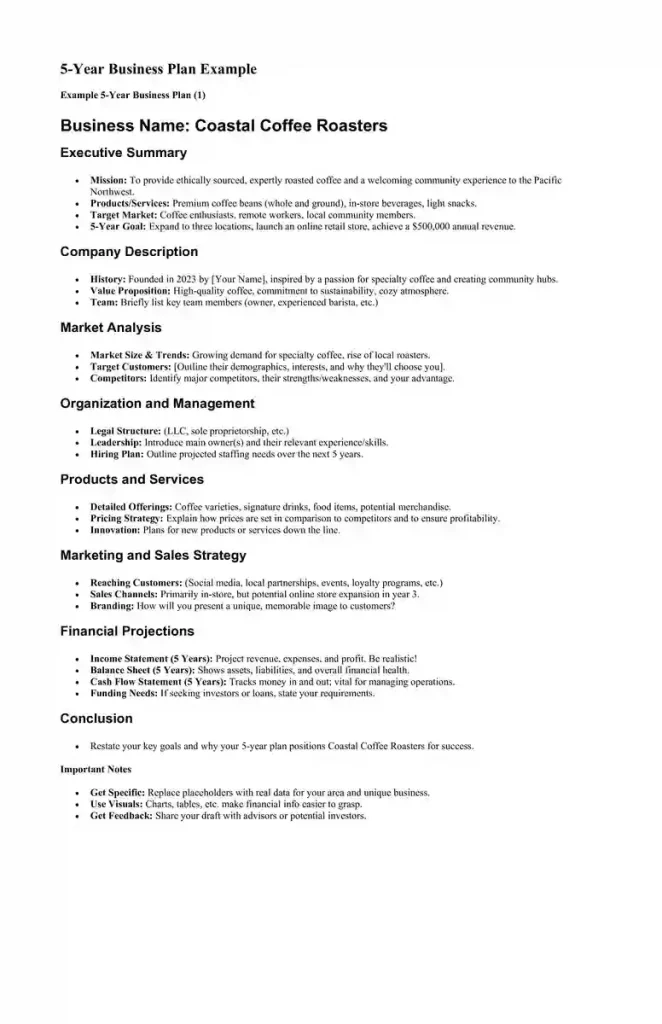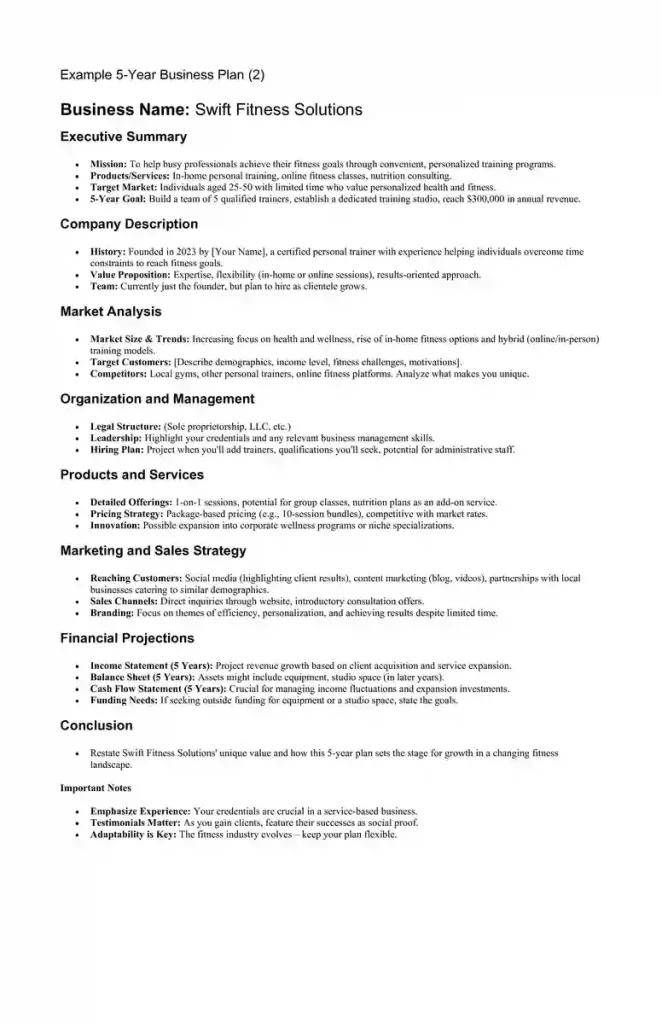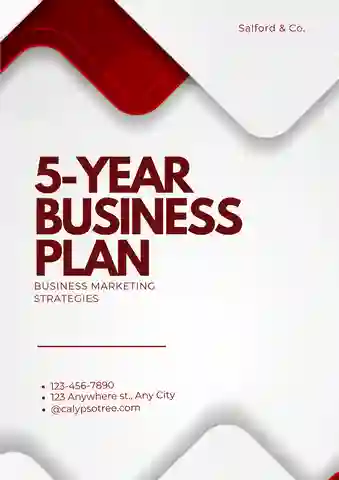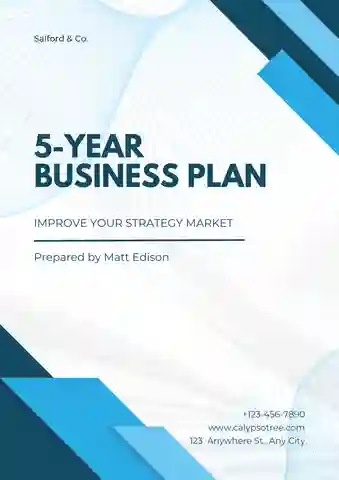Imagine your business five years from now. Where do you want it to be? A business plan is like a map to help get you there. It outlines your goals and how you’ll reach them. A 5-year business plan example gives you a big-picture view for the future of your company.
Key Components of a 5-Year Business Plan
Key components of a 5-year business plan:
Executive Summary
- Think of it as the “elevator pitch” for your business plan. This section should be brief (around one page) but powerful.
- Summarize the most compelling elements: Your company’s mission statement, the problem you solve, your target market, a highlight of your competitive advantage, and your key financial goals for the next five years.
Company Description
- Provide the backstory. When was your business founded? What were the motivations behind starting it?
- Explain your value proposition: What sets you apart from the competition? Why should customers choose you over others?
- Describe your company culture: What values guide you? A strong culture helps attract the right talent and build customer loyalty.
Market Analysis
- Know your playing field: What is the overall size of your market? Is it growing, shrinking, or staying the same? What trends could impact it in the future?
- Customer profiling: Create a detailed picture of your ideal customer. Go beyond demographics (age, location) to include their pain points, motivations, and how they make buying decisions.
- Competitor analysis: Identify your direct and indirect rivals. Analyze their strengths, weaknesses, and how you’ll position your business to stand out. A SWOT analysis (Strengths, Weaknesses, Opportunities, Threats) can be helpful here.
Organization and Management
- Showcase your team: Summarize the expertise and experience of your key leaders. Highlight any skills gaps you plan to fill as you grow.
- Organizational structure: Provide a visual chart of how your business is structured (who reports to whom). This shows how decisions are made.
- Hiring strategy: Outline your plans for attracting top talent. What are your expectations for employee growth within the 5-year period?
Products and Services
- Itemize: Provide a clear breakdown of your current offerings, including pricing structures.
- Innovation roadmap: Do you have plans for new products or services? Briefly outline any research & development plans and estimated timelines.
- Competitive differentiation: For each product/service, explain how it’s unique vs. the competition.
Marketing and Sales Strategy
- Target audience segments: If you have different types of ideal customers, break down how you’ll reach each one.
- Marketing mix: Outline the channels you’ll use (website, social media, events, advertising, etc.) and the key messages for each.
- Sales process: How will you convert leads into paying customers? Will you have a dedicated sales team, use online channels, or a mix?
Financial Projections
- Income statement: Projects your revenue, costs, and profitability over the 5 years.
- Balance sheet: Shows your company’s assets, liabilities, and overall financial health at specific points in time.
- Cash flow statement: This is critical! Tracks cash coming in and out to ensure you have enough to pay bills and make investments.
- Assumptions: Clearly state all the factors your financial projections are based upon. This is important for transparency and risk assessment.
Why Use 5-Year Business Plan Example

Here’s a benefits of using a 5-year business plan or a template:
Key Reasons to Use a 5-Year Business Plan
1. Provides Focus and Direction:
- Forces you to think strategically about where you want your business to be in the future.
- Aligns day-to-day decisions with long-term objectives.
- Reduces the risk of getting sidetracked by short-term distractions or opportunities that don’t truly move you forward.
2. Identifies Potential Roadblocks:
- Thorough market research uncovers potential challenges ahead of time (e.g., competitors, changing consumer needs).
- Realistic financial projections help you anticipate cash flow issues.
- Contingency planning helps minimize the impact of unexpected events.
3. Attracts Investors and Funding:
- Investors want to see a well-considered plan before putting money into a business.
- Demonstrates that you’ve done your homework and are serious.
- Shows potential for profitability and a return on their investment.
4. Aligns Your Team:
- Creates a shared understanding of where the company is headed.
- Informs hiring decisions and helps you find employees with the right skills to match your growth strategy.
- Fosters a sense of collective ownership and drives motivation.
5. Measures Progress
- Sets benchmarks to gauge your performance against.
- Highlights areas where you’re excelling and those that need improvement.
- Keeps you accountable and helps you stay on track.
Tips for Creating a Successful 5-Year Business Plan

Set SMART Goals
- Specific: Avoid vague goals like “grow the business.” Instead, be precise. Example: “Increase website traffic by 30% within the first year.”
- Measurable: How will you know if you’ve achieved your goal? Example: “Track website traffic with Google Analytics and compare results month-over-month.”
- Achievable: Be ambitious, but don’t set yourself up for failure. Consider your resources and market realities.
- Relevant: Your goals should align with your overall business vision. Aiming for random growth won’t necessarily make you successful.
- Time-bound: Set deadlines! Example: “Achieve a 10% market share in the Southeast region within three years.”
Be Realistic
- Acknowledge challenges: Every business faces hurdles. Factor in potential delays, competitor moves, or economic shifts.
- Prepare alternate plans: Have contingency ideas ready. If plan A doesn’t work out, what’s your plan B or C?
- Data is your friend: Base projections on solid research, not wishful thinking. Look at historical trends and industry benchmarks.
Review and Adapt
- Regular Check-ins: Schedule quarterly or semi-annual reviews. Compare your progress to your projections.
- Don’t be afraid to change course: The business world is unpredictable. If your initial assumptions turn out wrong, it’s better to adjust your plan than to stubbornly stick with a failing strategy.
- Track, Analyze, Optimize: Use data to pinpoint what’s working and what’s not. Use this knowledge to make informed changes to your plan.
Example: Applying SMART Goals and Realism
Instead of a vague goal like “increase sales” consider something like this:
- SMART Goal: Increase sales of Product X by 25% in the Northeast Region within the next 12 months through targeted online marketing campaigns and strategic retail partnerships.
This goal is specific, measurable, seems achievable based on past data, directly relevant to business growth, and has a clear deadline.
Additional Tip: Get Feedback
- Share your draft plan with mentors, advisors, or potential investors. Even with the best intentions, we sometimes miss our blind spots. Getting outside perspectives can help refine and strengthen your 5-year business plan.
Common Problems & Solutions
Mistake 1: Guessing About Money
- Problem: If you think you’ll make way more money than is realistic or forget to plan for extra costs, your whole plan is in trouble.
- Solution:
- Study the past: Look carefully at how your business did before. Compare yourself to others in your field.
- Prepare for the unexpected: Things don’t always go smoothly! Plan for slow times or surprise bills.
- Ask for help: Have a business mentor or advisor check your financial predictions.
Mistake 2: Not Knowing Your Customers
- Problem: If you don’t understand who you’re selling to or what they need, your plan won’t work.
- Solution:
- Dig deep: Do surveys, read studies, and talk to real customers to learn about them.
- Spy on the competition: What do other businesses do well? Where could you be better?
- Think about the big picture: Could changes in the economy or new laws affect your business?
Mistake 3: Boring Goals
- Problem: Goals that are too easy or unclear won’t get your team excited. Investors might not be impressed either!
- Solution:
- Get specific: Use the SMART method – goals should be Specific, Measurable, Achievable, Relevant, and Time-bound.
- Connect to the big dream: Make sure your goals match the overall mission of your business.
- Aim high (but be realistic): Set challenging goals to inspire yourself, but don’t set yourself up for failure.
Mistake 4: A Plan That Can’t Change
- Problem: A plan that never changes is useless! The world moves fast.
- Solution:
- Regular check-ups: Review your plan every few months and update your predictions.
- Have a plan B (and C): What will you do if things go wrong?
- Change course if needed: Don’t stubbornly stick to a plan that isn’t working.
Mistake 5: All Talk, No Action
- Problem: A plan with big dreams but no steps to get there is just a daydream.
- Solution:
- Baby steps: Break big goals into smaller, easier milestones on a timeline.
- Who’s in charge?: Decide exactly who is responsible for each task.
- Measure your progress: Keep track of important numbers to see if you’re on target.
Extra Tip: Get another pair of eyes on your plan! Advisors, investors, or experienced business owners can spot problems you might have missed.
Changes Made:
- Shorter sentences and simpler words: For example, “underestimating” became “forgetting”.
- Direct, conversational tone: Questions and phrases like “Dig deep” make it more engaging.
- Visuals and formatting: Breaking up the text with headings and bullet points adds white space, making it easier for a younger reader to follow.
5-Year Business Plan Example
Example 5-Year Business Plan (1)

Business Name: Coastal Coffee Roasters
Executive Summary
- Mission: To provide ethically sourced, expertly roasted coffee and a welcoming community experience to the Pacific Northwest.
- Products/Services: Premium coffee beans (whole and ground), in-store beverages, light snacks.
- Target Market: Coffee enthusiasts, remote workers, local community members.
- 5-Year Goal: Expand to three locations, launch an online retail store, achieve a $500,000 annual revenue.
Company Description
- History: Founded in 2023 by [Your Name], inspired by a passion for specialty coffee and creating community hubs.
- Value Proposition: High-quality coffee, commitment to sustainability, cozy atmosphere.
- Team: Briefly list key team members (owner, experienced barista, etc.)
Market Analysis
- Market Size & Trends: Growing demand for specialty coffee, rise of local roasters.
- Target Customers: [Outline their demographics, interests, and why they’ll choose you].
- Competitors: Identify major competitors, their strengths/weaknesses, and your advantage.
Organization and Management
- Legal Structure: (LLC, sole proprietorship, etc.)
- Leadership: Introduce main owner(s) and their relevant experience/skills.
- Hiring Plan: Outline projected staffing needs over the next 5 years.
Products and Services
- Detailed Offerings: Coffee varieties, signature drinks, food items, potential merchandise.
- Pricing Strategy: Explain how prices are set in comparison to competitors and to ensure profitability.
- Innovation: Plans for new products or services down the line.
Marketing and Sales Strategy
- Reaching Customers: (Social media, local partnerships, events, loyalty programs, etc.)
- Sales Channels: Primarily in-store, but potential online store expansion in year 3.
- Branding: How will you present a unique, memorable image to customers?
Financial Projections
- Income Statement (5 Years): Project revenue, expenses, and profit. Be realistic!
- Balance Sheet (5 Years): Shows assets, liabilities, and overall financial health.
- Cash Flow Statement (5 Years): Tracks money in and out; vital for managing operations.
- Funding Needs: If seeking investors or loans, state your requirements.
Conclusion
- Restate your key goals and why your 5-year plan positions Coastal Coffee Roasters for success.
Important Notes
- Get Specific: Replace placeholders with real data for your area and unique business.
- Use Visuals: Charts, tables, etc. make financial info easier to grasp.
- Get Feedback: Share your draft with advisors or potential investors.
Example 5-Year Business Plan (2)

Business Name: Swift Fitness Solutions
Executive Summary
- Mission: To help busy professionals achieve their fitness goals through convenient, personalized training programs.
- Products/Services: In-home personal training, online fitness classes, nutrition consulting.
- Target Market: Individuals aged 25-50 with limited time who value personalized health and fitness.
- 5-Year Goal: Build a team of 5 qualified trainers, establish a dedicated training studio, reach $300,000 in annual revenue.
Company Description
- History: Founded in 2023 by [Your Name], a certified personal trainer with experience helping individuals overcome time constraints to reach fitness goals.
- Value Proposition: Expertise, flexibility (in-home or online sessions), results-oriented approach.
- Team: Currently just the founder, but plan to hire as clientele grows.
Market Analysis
- Market Size & Trends: Increasing focus on health and wellness, rise of in-home fitness options and hybrid (online/in-person) training models.
- Target Customers: [Describe demographics, income level, fitness challenges, motivations].
- Competitors: Local gyms, other personal trainers, online fitness platforms. Analyze what makes you unique.
Organization and Management
- Legal Structure: (Sole proprietorship, LLC, etc.)
- Leadership: Highlight your credentials and any relevant business management skills.
- Hiring Plan: Project when you’ll add trainers, qualifications you’ll seek, potential for administrative staff.
Products and Services
- Detailed Offerings: 1-on-1 sessions, potential for group classes, nutrition plans as an add-on service.
- Pricing Strategy: Package-based pricing (e.g., 10-session bundles), competitive with market rates.
- Innovation: Possible expansion into corporate wellness programs or niche specializations.
Marketing and Sales Strategy
- Reaching Customers: Social media (highlighting client results), content marketing (blog, videos), partnerships with local businesses catering to similar demographics.
- Sales Channels: Direct inquiries through website, introductory consultation offers.
- Branding: Focus on themes of efficiency, personalization, and achieving results despite limited time.
Financial Projections
- Income Statement (5 Years): Project revenue growth based on client acquisition and service expansion.
- Balance Sheet (5 Years): Assets might include equipment, studio space (in later years).
- Cash Flow Statement (5 Years): Crucial for managing income fluctuations and expansion investments.
- Funding Needs: If seeking outside funding for equipment or a studio space, state the goals.
Conclusion
- Restate Swift Fitness Solutions’ unique value and how this 5-year plan sets the stage for growth in a changing fitness landscape.
Important Notes
- Emphasize Experience: Your credentials are crucial in a service-based business.
- Testimonials Matter: As you gain clients, feature their successes as social proof.
- Adaptability is Key: The fitness industry evolves – keep your plan flexible.





Your Turn!
A 5-year business plan helps you make smart choices for the future. It’s time to start building your own!
FAQs: 5-Year Business Plans
What’s the difference between a business plan and a 5-year business plan?
A traditional business plan is a snapshot of your business now – its structure, offerings, and goals. A 5-year plan charts a longer path, forecasting growth and outlining strategies for the next several years.
My business is brand new. Do I still need a 5-year plan?
Yes! A 5-year plan is especially important for new businesses. It forces you to define your vision, understand your market, and map out how you’ll achieve growth.
Isn’t 5 years too long to predict? Things change fast!
You’re right! A 5-year plan isn’t a rigid, unchangeable document. It’s about setting a direction and then regularly reviewing and revising it as needed.
Creating a 5-year plan seems overwhelming. Where do I start?
Start small! Focus on your mission statement (why your business exists) and one or two major goals you want to hit in the next 5 years. You can build out the rest later.
Do I need to hire a consultant to make my 5-year plan?
Not necessarily. There are many templates and online resources to guide you. However, if you need in-depth advice or want to present your plan to investors, professional help is worthwhile.
Is there a specific format use?
There are standard components most plans include (executive summary, market analysis, etc.), but some flexibility is allowed. Focus on making it clear, organized, and realistic.
How often should I update my 5-year plan?
Aim for at least an annual review. Quarterly check-ins are even better, especially if your industry moves quickly.
What if I don’t reach all the goals in my plan?
That’s okay! Plans are tools for learning and adapting. Analyze why goals were missed and adjust your strategies.

The content creator team at calipsotree.com is dedicated to making topics accessible to everyone, with over 9 years of experience in writing and breaking down complex concepts into easy-to-understand articles that answer readers’ financial questions.








